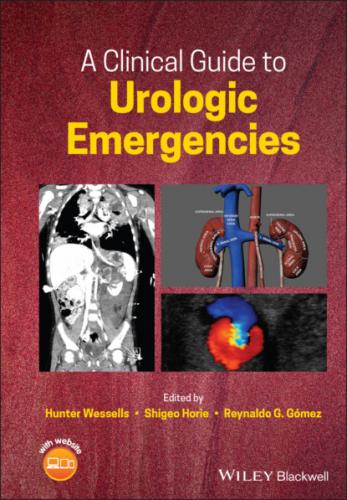A Clinical Guide to Urologic Emergencies. Группа авторов
(print) | LCC RC874.8 (ebook) | NLM WJ 140 | DDC 616.6/025–dc23
LC record available at https://lccn.loc.gov/2020040342 LC ebook record available at https://lccn.loc.gov/2020040343
Cover Design: Wiley
Cover Images: X‐ray and ultrasound images © Hunter Wessells, Image of the kidneys and their association with adjacent organs © Daniel Burke, University of Washington
Dedication
To all those who served in the COVID‐19 pandemic and to those we lost.
To the patients, students, residents, fellows and colleagues at UW Medicine and Harborview who contributed to the knowledge in this volume, as well as my family for their unwavering support. H.W.
To my patients, colleagues, and students past, present and future. To my family for their support. To my mentors of emergency medicine, Drs. Mii, Toyooka and Morita for enlightening and inspiring me. S.H.
To my parents for the effort they put into my education, my masters for guiding my curiosity, my patients for their trust, my hospital’s staff support along over 35 years and my family for their patience and for inspiring my work. R.G.G.
List of Contributors
Justin S. Ahn Department of Urology, UCSF School of Medicine, San Francisco, CA, USA
Nayib Fakih Division of Urology, Hospital Universitario San Ignacio, Pontificia Universidad Javeriana, Bogota, Colombia
Nicolas Fernandez Division of Pediatric Urology, Seattle Children's Hospital, University of Washington, Seattle, WA, USA
Bradley D. Figler Department of Urology, University of North Carolina‐Chapel Hill, Chapel Hill, NC, USA
Ariel Fredrick Lahey Hospital and Medical Center, Lahey Institute of Urology at Portsmouth and Rochester, Portsmouth and Rochester, NH, USA
Dr. Juan Fullá Clinica Las Condes, Las Condes, Chile
Reynaldo G. Gómez Urology Service, Hospital del Trabajador, Santiago, Chile
Marios Hadjipavlou Guy's Hospital, London, UK
Lindsay A. Hampson Department of Urology, UCSF School of Medicine, San Francisco, CA, USA
Jonathan D. Harper Department of Urology, University of Washington School of Medicine, Seattle, WA, USA
Sarah K. Holt Department of Urology, University of Washington School of Medicine, Seattle, WA, USA
Shigeo Horie Department of Urology, Juntendo University Graduate School of Medicine, Tokyo, Japan
Akio Horiguchi Department of Urology, National Defense Medical College, Tokorozawa, Japan
Steven J. Hudak UT Southwestern Medical Center, Dallas, TX, USA
Kazuyoshi Iijima Department of Urology, Nagano Municipal Hospital, Nagano, Japan
Akash A. Kapadia Department of Urology, University of Washington School of Medicine, Seattle, WA, USA
Haruaki Kato Department of Urology, Nagano Municipal Hospital, Nagano, Japan
Kosuke Kitamura Department of Urology, Juntendo University Graduate School of Medicine, Tokyo, Japan
Rajeev Kumar All India Institute of Medical Sciences, New Delhi, India
Rachel McKenzie Department of Urology, University of Washington School of Medicine, Seattle, WA, USA
Joseph Meno Department of Urology, University of Washington School of Medicine, Seattle, WA, USA
Nnenaya Mmonu Department of Urology, UCSF School of Medicine, San Francisco, CA, USA
Yosuke Nakajima Kawasaki Municipal Ida Hospital, Kawasaki, Japan
Brusabhanu Nayak All India Institute of Medical Sciences, New Delhi, India
Tomohiko Oguchi Department of Urology, Nagano Municipal Hospital, Nagano, Japan
Kevin Ostrowski Department of Urology, University of Washington School of Medicine, Seattle, WA, USA
Rishi R. Sekar Department of Urology, University of Washington School of Medicine, Seattle, WA, USA
Davendra Sharma St George's Hospital, London, UK
Alexander J. Skokan Harborview Medical Center, University of Washington School of Medicine, Seattle, WA, USA
Nitin Srivastava All India Institute of Medical Sciences, New Delhi, India
Hong Truong Department of Urology, Thomas Jefferson University Hospital, Philadelphia, PA, USA
Alex J. Vanni Center for Reconstructive Urologic Surgery, Lahey Hospital and Medical Center, Burlington, MA, USA
Laura G. Velarde Urology Service, Hospital del Trabajador, Santiago, Chile
Humberto G. Villarreal Loma Linda University Medical Center, Loma Linda, CA, USA
Thomas J. Walsh Department of Urology, University of Washington School of Medicine, Seattle, WA, USA
Dana A. Weiss The Children's Hospital of Philadelphia, Philadelphia, PA, USA
Hunter Wessells Department of Urology, University of Washington School of Medicine, Seattle, WA, USA
Jonathan Wingate Madigan Army Medical Center, Tacoma, WA, USA
Seiji Yano Department of Urology, Nagano Municipal Hospital, Nagano, Japan
Norman Zambrano Clinica Las Condes, Las Condes, Chile
Preface
A Clinical Guide to Urologic Emergencies
The burden of urological disease worldwide is driven by a range of common conditions, some of which impair health acutely and others through chronic pathophysiological processes. Urological emergencies, when untreated, can lead to death, permanent disability, and lifelong reductions in quality of life. History is replete with examples including urinary stone disease in ancient Egypt and descriptions of combat wounds by Ambrose Pare in the Renaissance; this book will highlight common indications for acute urological intervention as well the emergence of unforeseen mechanisms of injury such as necrotizing genital skin infections associated with the introduction of novel sodium‐glucose cotransporter 2 (SGLT2) inhibitors for diabetes and the contemporary battlefield injuries of such immense complexity as to require the re‐engineering of military care.
Variation in population demographics, access to care, workforce capacity, and technology have a profound effect on how a given segment of the population will experience illness. The Global Burden of Disease, a tool to quantify health loss from hundreds of diseases, injuries, and risk factors, demonstrates that the determinants of health vary greatly by geography, whether continent‐, country‐, or county‐level. These disparities have been brought into sharper focus by the pandemic of COVID‐19, which exerts a disproportionate impact on individuals from minority populations in the United States and
